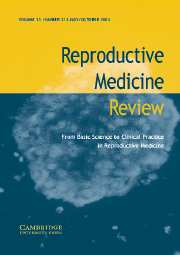Article contents
Postcoital contraception
Published online by Cambridge University Press: 02 March 2009
Extract
As early as 1500 BC, history records women using a variety of drugs, devices and manoeuvres in an attempt to prevent pregnancy after intercourse has taken place. It was not until the 1960s however that scientific efforts were made to develop effective postcoital contraception (PCC). Whilst it had been known for over thirty years that a variety of compounds would inhibit implantation and embryonic development and interrupt pregnancy in the rabbit and the rat, experiments with primates had been less successful. In 1966 however, Morris and Van Wagenen reported the prevention of pregnancy in 28 macaque monkeys treated with oestradiol, diethylstilboestrol or a synthetic compound (ORF 3858), administered after mating. In the same paper – and confessing that they embarked upon human experimentation ‘with some trepidation’ – the authors reported that 50 mg diethylstilboestrol (DES) given for four to six days appeared to be effective in preventing pregnancy after intercourse had taken place in an undisclosed number of women who were the victims of rape.
- Type
- Articles
- Information
- Copyright
- Copyright © Cambridge University Press 1993
References
- 5
- Cited by


